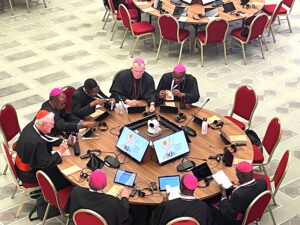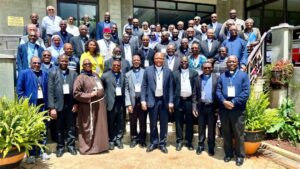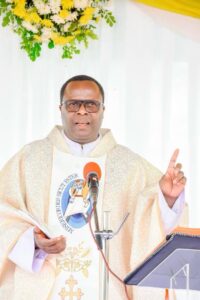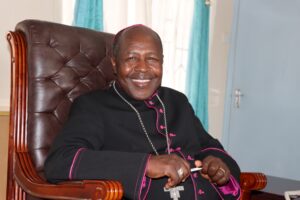VATICAN SYNOD: Synod Assembly Participants Witness Harmony Despite Diverging Points on Issues

Fr. Andrew Kaufa SMM
By half past eight, Monday, October 16, 2023, Pope Francis was already seated in the Synod hall of Paul VI, to listen to the working groups reports on the synodal way of carrying out the mission of Jesus Christ. The content of the reports simply affirmed that members of the assembly were in earnest business as he appealed to the faithful in his address to the Church in Archdiocese of Rome dated 18th August 2021, that the synodal process which was about to start at that time, was going to be a serious journey.
“I came here to encourage you to take this synodal process seriously and to tell you that the Holy Spirit needs you. It is true, the Holy Spirit needs us. Listen to him by listening to each other. Leave no one behind or excluded,” said Pope Francis.
And if there is anyone serious about the ongoing synodal assembly which started on October 4, 2023, it is Pope Francis himself who has amazed the assembly with his punctuality whenever there is a General Congregation.
Divergence in Communion
Among the Ngoni people, there is a saying “The mother’s breasts have crushed” to mean that when children who sucked from the same mother have been in a conflict, it is normal and they must be left alone. When introducing the fourth module of the assembly, the Relator General of the Synod, Cardinal Jean-Claude Hollerich, had already foreseen that at this point of the universal synodal gathering, the participants should expect that there will be some points of convergence than divergence and more questions that will seek more research and reflection. The points of divergence can easily bring tension in the working groups but also in the General Congregation. According to the Instrumentum Laboris (IL), the assembly was to reflect on specific and critical questions that came up in the reports from the dioceses and continents. With due respect to the obligation of confidentiality, tension also became obvious from the cleverly crafted questions of the journalists during a press briefing as they sought to find out what the panelists expected out of the synod about women’s ordination to priesthood and diaconate, whether there was convergence or divergence on issues such as blessing of homosexual couples and whether or not to open up to people of LGTPQ+.
“Around sexual identity, do you think this assembly is not polarized as the previous ones,? One journalist asked, to which the panelist replied, “What we are seeing in the assembly is that people are freely discussing issues at a more profound level than the journalistic way.”
In any case, the key question according to the Instrumentum Laboris section B2 was to invite the participants into a reflection on what could be a synodal way of doing the mission. This is in recognition that the Church is missionary by nature, and at the same time, it is universal, multicultural, and diverse. In other words, a positive way of looking at it is to seek to appreciate all these as the beauty of the Catholic Church. But then, as a family of God, how can the universal Church in its diversity share the gifts and tasks in the service of the Gospel? For instance, what can the Western churches that are rich when it comes to financial resources share with the churches in Asia and Africa which are poor in financial resources but rich in the number of ordained ministers and active Christians?
A Symphony from Diversity
This is one of the unique features of this synod, according to some of the bishops who have attended three or more synods before the current one, the emphasis on listening and silence is enabling them to learn from one another how to be a synodal Church. In fact, the spiritual conversation as they are calling it, is allowing participants to differ in opinions based on their contextual diversities, yet at the end of each discussion, there is a symphony that is created.
Another thing noted by the participants is that where there is convergence of opinion, they can still agree that a synodal Church will not come on a silver platter. It will require the church to school all its members about this process of dialoguing. Therefore, the Church ought to invest in the formation of its members beginning with the bishops and priests, but above all the seminarians who are the future priests and the laity themselves.
Testimonies of Togetherness
The discussion on a synodal way of doing the mission of Christ extended to almost three and a half days. Going back to the curiosity of the journalists gathered at the Sala Stampa on Monday, October 16, the three guests of the day in the name of Most Rev. Zdenek Wasserbauer of Prague Archdiocese in Czech Republic, Fr Vimal Tirimanna a Moral Theologian from Sri Lanka and Sr Patricia Murray IBVM an Irish nun serving as Executive Secretary of the Union of Superior General (IUSG) took turns to insist that this synod is not about particular issues by how the Church in its diversity can journey together.
“Today, the mission is our topic and I can tell you, after more than 2 weeks in the meeting, I feel stronger than before. What is the mission of the Church? For me, it is for the good and freedom of the other. I feel strongly that the 400 people who are gathered at the Synod hall are wishing good for the Church and for all the members of the family of God. In Rome, at this moment, 400 people have taken time to look for ways to help others who do not feel welcome in the Church, and to understand them,” said Archbishop Wasserbauer.
On her part, Sr Patricia Murray said, “We Sisters have been living the spirit of synodality for years. In the synod, we are simply saying, this is the way to be church and to do our mission. Asking deeper questions in a prayerful mode, that’s how discernment is happening. In listening to the topic from different backgrounds and experiences, that is how we are discerning.
Saint Theresa, a Model for the Western Church
Referencing Pope Francis’ newly released Apostolic Exhortation C’est la Confiance (It is confidence) article numbers 9-11 where the Holy Fathers discuss the essence of a missionary soul according to Saint Therese of the Child Jesus, Archbishop Wasserbauer noted that despite being aware of her impending death, Therese’s apostolic zeal remained fervent. Therefore, the Western Church which is in a way going through the dark night of faith need not give up on her mission, even amidst the difficulty of dealing with issues of pastoral concern which include wars and the scandal of sexual abuse, to mention a few. According to him, amidst the depth of this dark night of faith in Europe and other parts of the world, Saint Theresa of the Child Jesus is a model to the synodal Church.
Conclusion
From October 18, the synodal assembly has journeyed on to B3 questions in the Instrumentum Laboris where the focus is on how to be a synodal Church with regard to the office of the bishop, governance, and authority. This will be a story for another day, but for Section B2, it can be said that the punchline could be the testimony of Archbishop Wasserbauer who said: “For me, this Synod is helping to illuminate today’s darknesses, to bring light into the various dark nights and twilights in the life of the Church of our time.”


